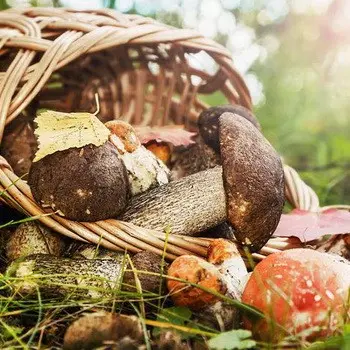 With the onset of the summer season, the soil begins to warm up, and there are more and more objects for “silent hunting”. Of the edible mushrooms that are harvested in the summer, semi-white mushrooms are the first to appear. They grow in slightly elevated, well-warmed places. Mossiness mushrooms, psatirells and udemansiella ripen behind them. And from among the first inedible summer mushrooms, the most common in the Moscow region are mycenae and rows.
With the onset of the summer season, the soil begins to warm up, and there are more and more objects for “silent hunting”. Of the edible mushrooms that are harvested in the summer, semi-white mushrooms are the first to appear. They grow in slightly elevated, well-warmed places. Mossiness mushrooms, psatirells and udemansiella ripen behind them. And from among the first inedible summer mushrooms, the most common in the Moscow region are mycenae and rows.
In Our Country, tubular mushrooms are most often harvested from summer mushrooms: white, semi-white, boletus, boletus, boletus. In some foreign countries lamellar species of mushrooms such as mushrooms, champignons are preferred.
About what mushrooms are harvested in the summer, and what inedible species appear in the forests in June, you will learn by reading this material.
What types of mushrooms are harvested in summer
Semi-white mushroom, or yellow boletus (Boletus impolitus).
Habitats: singly and in groups in deciduous and mixed forests.
Season: from June to September.
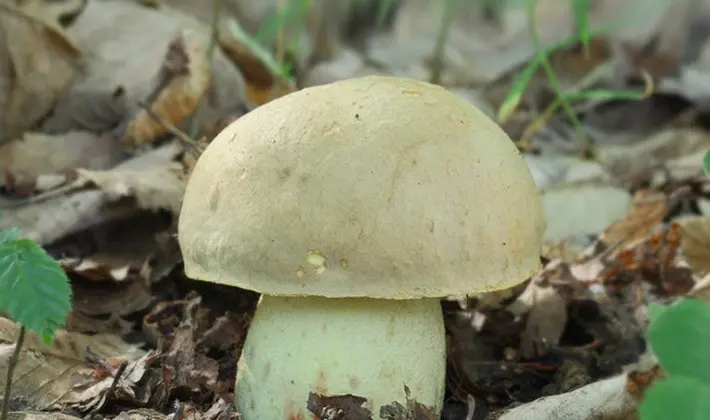
The hat is 5-15 cm in diameter, sometimes up to 20 cm, at first hemispherical, later cushion-shaped and convex. A distinctive feature of the species is a slightly felted clay or yellow-brown hat with small, slightly darker specks. Over time, the surface of the cap cracks. The skin is not removed.
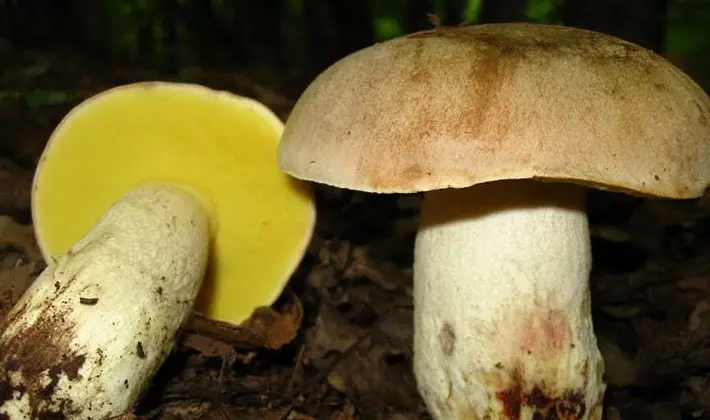
Leg 4-15 cm high, 1-4 cm thick. The stalk is first white-cream in color, and later gray-yellowish or yellow-brownish.
As shown in the photo, in these summer mushrooms, the upper part of the leg is lighter, straw:
The surface is rough, fleecy at the base, without a mesh pattern.
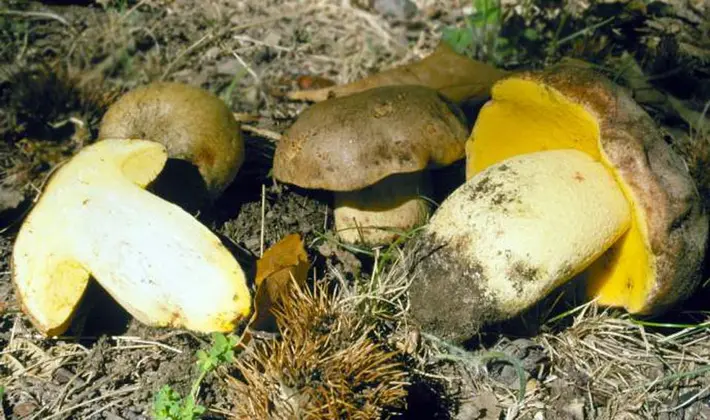
The pulp is dense, at first whitish, later light yellow, does not change color on the cut, the taste is pleasant, sweetish, the smell is slightly reminiscent of iodoform.
The tubular layer is free, first yellow, later olive-yellow, does not change color when pressed. Spores are olive-yellow.
Variability: the color of the cap varies from light olive-yellow to yellow-brown.
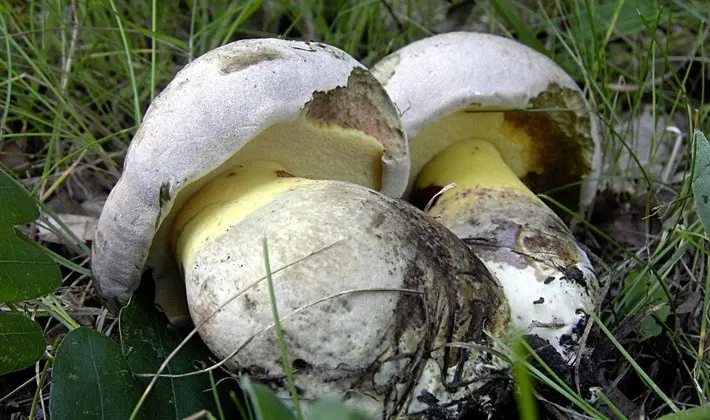
Similar types. The semi-white mushroom is also similar to edible stocky boletus (Boletus radicans), which turns blue on the cut and when pressed.
Cooking methods: pickling, salting, frying, soups, drying.
Edible, 2rd and 3th category.
Boletus.
Speaking about what mushrooms grow in summer, of course, it is necessary to talk about mossiness mushrooms. These are rare, but unusually attractive mushrooms. In terms of their taste, they are close to boletus. Their first wave appears in June, the second – in August, the late wave may be in October.
Velvet flywheel (Boletus prunatus).
Habitats: grows in deciduous, coniferous forests.
Season: June-October.
Hat with a diameter of 4-12 cm, sometimes up to 15 cm, hemispherical. A distinctive feature of the species is a dry matte, velvety brown hat with lighter edges. The skin on the hat is dry, fine-grained and almost felt, becoming smoother with time, a little slippery after rain.
Look at the photo – these mushrooms growing in summer have a cylindrical leg, 4-10 cm high, 6-20 mm thick:
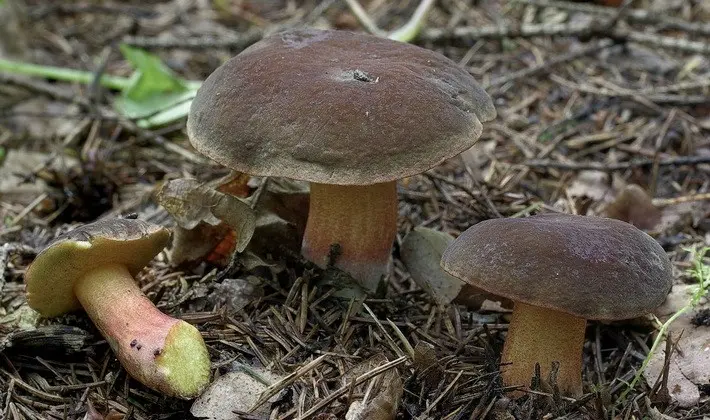
The stem is usually painted in lighter colors than the hat, which is often curved. Creamy yellow and reddish color preferred.
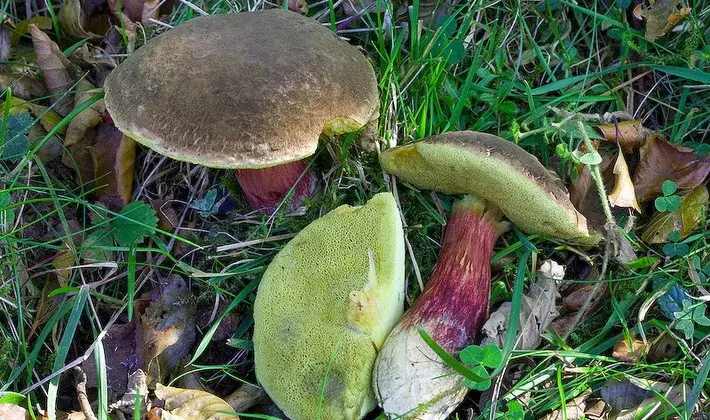
The flesh is dense, whitish with a yellowish tint, slightly turning blue when pressed. The flesh of these edible summer mushrooms has a slight mushroom taste and smell.
The tubules are creamy-yellowish when young, later yellow-green. Spores are yellowish.
Variability: the cap eventually becomes dry and velvety, and the color of the cap varies from brown to reddish-brown and brown-brown. The color of the stem varies from light brown and yellow-brown to reddish-brown.
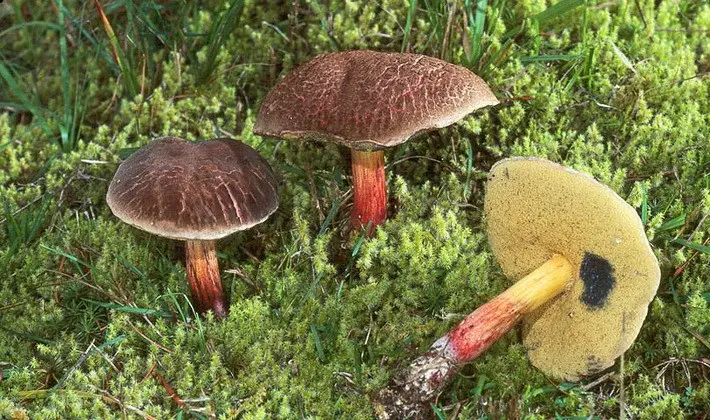
There are no toxic twins. Mokhovik velvet is similar in shape to variegated flywheel (Boletus chtysenteron), which is distinguished by the presence of cracks on the cap.
Cooking methods: drying, marinating, boiling.
Edible, 3th category.
Psatirella.
In the June forest there are many inconspicuous whitish-yellowish mushrooms with a hat in the form of an umbrella. These first mushrooms grow everywhere in summer, especially near forest paths. They are called psatirella Candoll.
Psathyrella Candolleana (Psathyrella Candolleana).
Habitats: soil, rotten wood and stumps of deciduous trees, growing in groups.
Season: June-October.
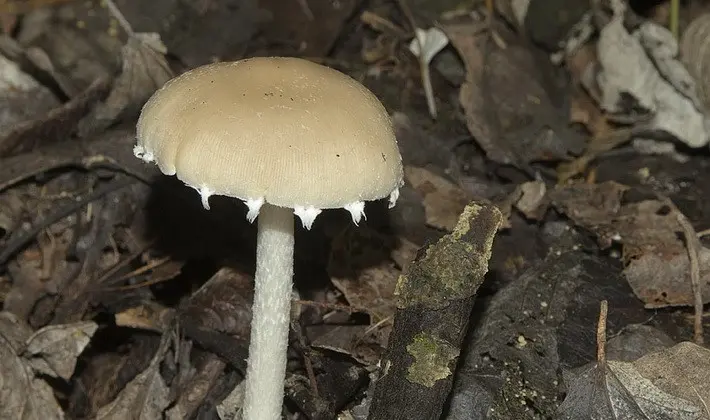
The cap has a diameter of 3-6 cm, sometimes up to 9 cm, at first bell-shaped, later convex, later convex prostrate. A distinctive feature of the species is at first a whitish-yellowish, later with purple edges, a hat with white flakes along the edge and a smooth white-cream leg. In addition, thin radial fibers are often visible on the surface of the cap.
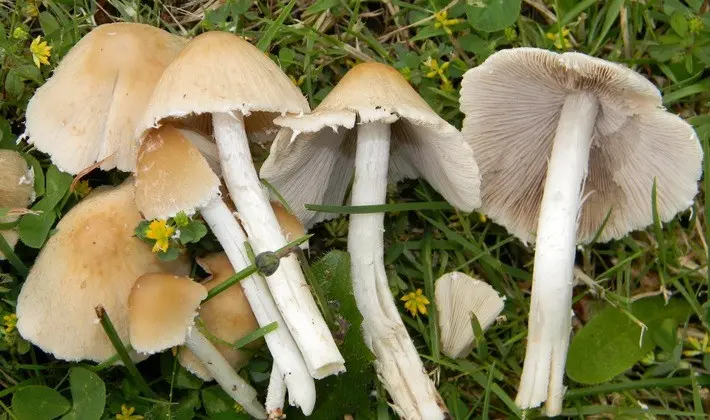
The leg is 3-8 cm high, 3 to 7 mm thick, fibrous, slightly widened near the base, brittle, white-cream with a slight flaky coating in the upper part.

Pulp: first whitish, later yellowish, in young specimens without a special smell and taste, in mature and old mushrooms – with an unpleasant odor and a bitter taste.
The plates are adherent, frequent, narrow, whitish at first, later gray-violet, gray-pink, dirty brown, gray-brown or dark purple.
Variability. The color of the cap can vary from white-cream to yellowish and pinkish-cream in young specimens and yellow-brown and with purple edges in mature specimens.
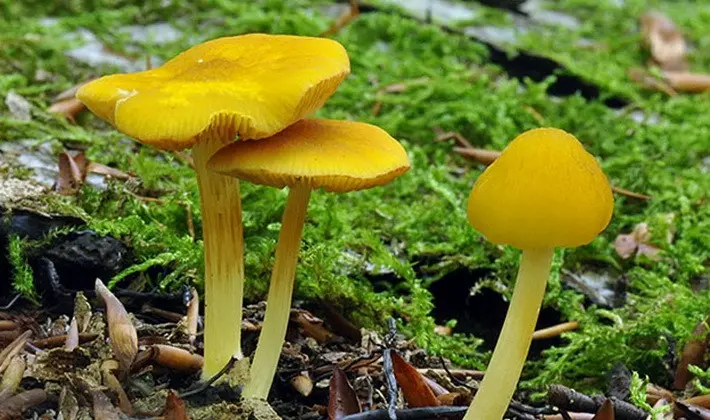
Similar types. Psatirella Candolla is similar in shape and size to the golden yellow whip (Pluteus luteovirens), which is distinguished by a golden yellow hat with a darker center.
Conditionally edible, since only the youngest specimens can be eaten and no later than 2 hours after collection, in which the color of the plates is still light. Mature specimens produce black water and a bitter taste.
These photos show the summer mushrooms described above:
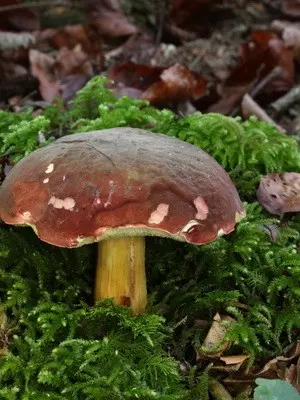
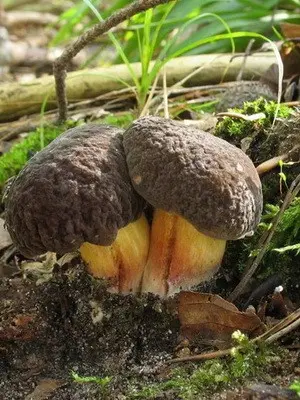
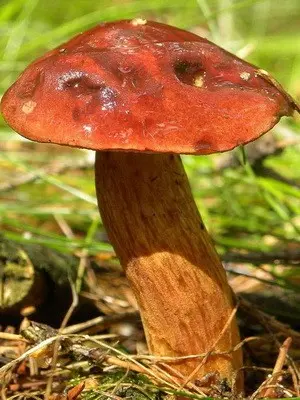
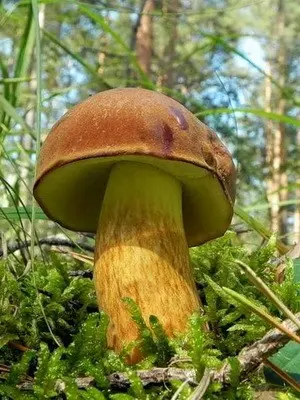
Udemansiella.
In the pine forests in the Moscow region, you can find unusual summer mushrooms – radiant udemansiella with radial stripes on the hat. At a young age they are light brown, and with age they become dark brown and are clearly visible on the litter of pine needles.
Udemansiella radiant (Oudemansiella radicata).
Habitats: deciduous and coniferous forests, in parks, at the base of trunks, near stumps and on roots, usually grow singly. A rare species, listed in the regional Red Books, status – 3R.
These mushrooms are harvested in the summer, starting in July. The collection season ends in September.

The cap has a diameter of 3-8 cm, sometimes up to 10 cm, at first convex prostrate with a blunt tubercle, later almost flat and then, like a wilted flower, with dark brown edges falling down. A distinctive feature of the species is the light brown color of the cap and the convex pattern of the tubercle and radial stripes or rays. From above, these bulges look like a camomile or other flower. The cap is thin and wrinkled.
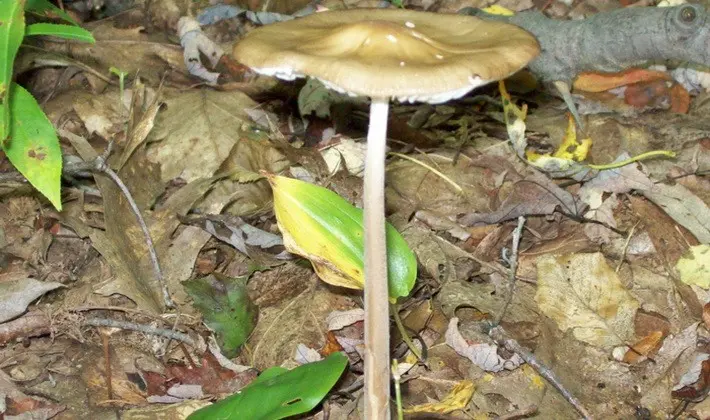
Leg long, 8-15 cm tall, sometimes up to 20 cm, 4-12 mm thick, widened at the base, deeply immersed in the soil, with a root-like process. In young mushrooms, the color of the stalk is almost uniform – whitish, in mature mushrooms – whitish on top with a powdery coating, light brownish in the middle and the stalk is often twisted, below – dark brown, longitudinally fibrous.
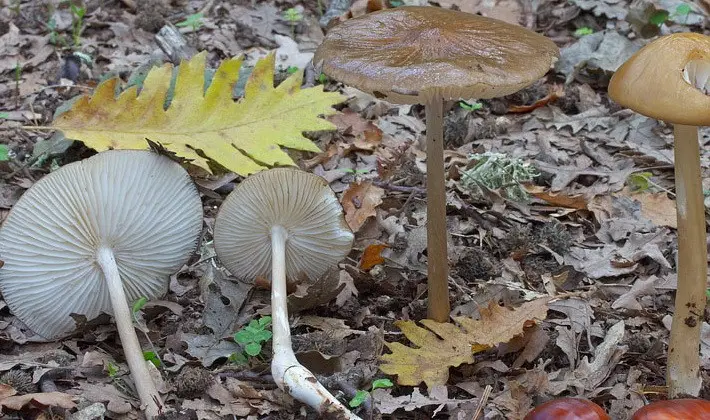
The flesh of these mushrooms, growing in summer, is thin, whitish or grayish, without much odor.
The plates are rare, adherent, later free, white, grayish.
Variability: the color of the cap varies from gray-brown to gray-yellow, yellow-brown, and in old age to dark brown and becomes similar in shape to a dark flower with petals down.
Similar types. Oudemansiella radiata is so characteristic and unique due to the presence of radiant bulges on the cap that it is difficult to confuse it with another species.
Cooking methods: boiled, fried.
Edible, 4th category.
In the next section of the article, you will learn which mushrooms that grow in summer are inedible.
Inedible summer mushrooms
Mycenae.
Mycenae appear on stumps and rotten trees in the June forest. These small mushrooms on a thin stalk, although they are inedible, give the forest a unique and peculiar look of diversity and fullness.
Mycena amicta (Mycena amicta).
Habitat: coniferous and mixed forests, on stumps, at the roots, on dying branches, growing in large groups.
Season: June-September.

The cap has a diameter of 0,5-1,5 cm, bell-shaped. A distinctive property of the species is a bell-shaped hat with pressed edges with a small tubercle, similar to a button, light cream in color with a yellow-brown or olive-brown center and with a slightly ribbed edge. The surface of the cap is covered with small scales.
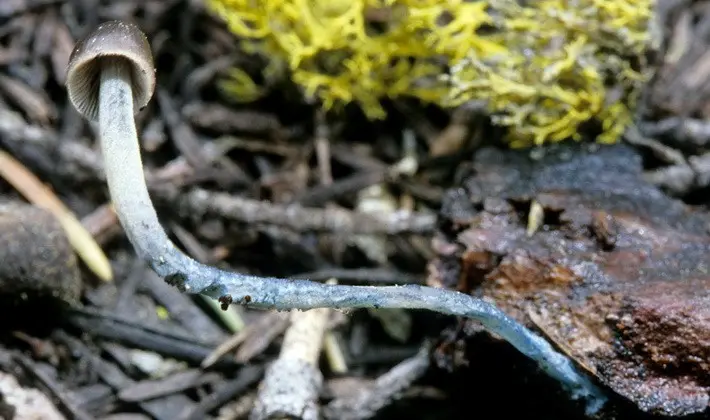
The stalk is thin, 3-6 cm tall, 1-2 mm thick, cylindrical, smooth, sometimes with a root process, at first translucent, later grayish-brownish, covered with fine whitish grains.
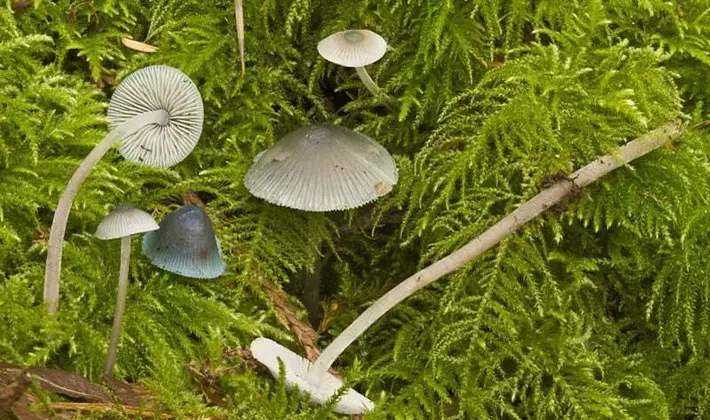
The flesh is thin, whitish, has an unpleasant odor.
The plates are frequent, narrow, slightly descending along the stem, first white, later gray.
Variability: the color of the cap in the middle varies from yellow-brown to olive-brown, sometimes with a bluish tint.
Similar types. Mycena amicta in the color of the cap is similar to the inclined mycena (Mycena inclinata), which is distinguished by a cap-shaped cap and a light cream leg with a powdery coating.
Inedible due to an unpleasant odor.
Mycena pure, purple form (Mycena pura, f. violaceus).
Habitats: these mushrooms grow in summer in deciduous forests, among moss and on the forest floor, grow in groups and singly.
Season: June-September.
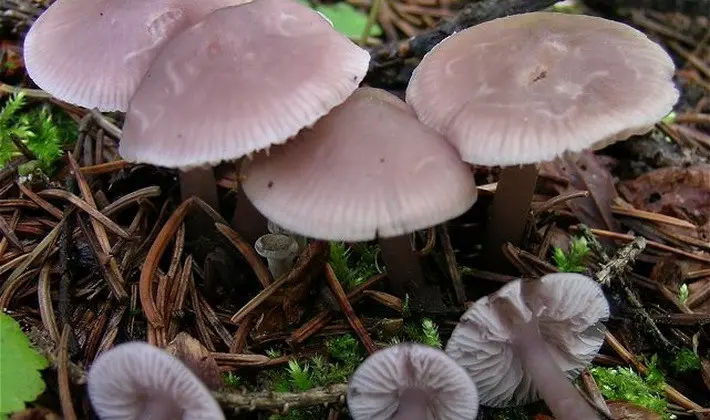
The cap has a diameter of 2-6 cm, at first cone-shaped or bell-shaped, later flat. A distinctive feature of the species is an almost flat shape of a lilac-violet base color with deep radial stripes and teeth of plates protruding at the edges. The hat has two color zones: the inner one is a darker purple-lilac, the outer one is a lighter lilac-cream. It happens that there are three color zones at once: the inner part is creamy yellowish or creamy pinkish, the second concentric zone is purple-lilac, the third, on the edge, is again light, as in the middle.
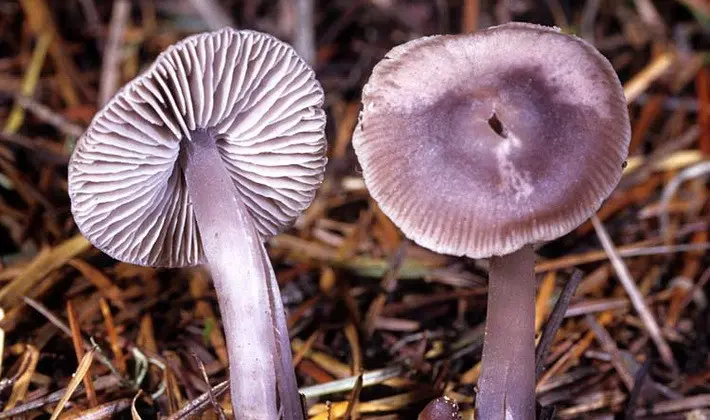
Leg 4-8 cm tall, 3-6 mm, cylindrical, dense, the same color as the cap, covered with many longitudinal lilac-blackish fibers. In mature specimens, the upper part of the leg is painted in light colors, and the lower part is dark.

The flesh at the cap is white, at the stem it is lilac, with a strong smell of radish and a taste of turnip.
The plates are rare, wide, adherent, between which there are shorter free plates.
Variability: the color of the cap varies greatly from pinkish-lilac to purple.
In plates, the color changes from white-pink to light purple.
Similar types. This mycena is similar to the cap-shaped mycena (Mycena galericulata), which is distinguished by the presence of a pronounced tubercle on the cap.
Inedible because they are tasteless.
Ryadovka.
The first June rows are inedible. They fill the blossoming forest with a peculiar charm.
Row white (Tricholoma album).
Habitats: deciduous and mixed forests, especially with birch and beech, mainly on acidic soils, grow in groups, often on edges, in shrubs, parks.
Season: July-October.
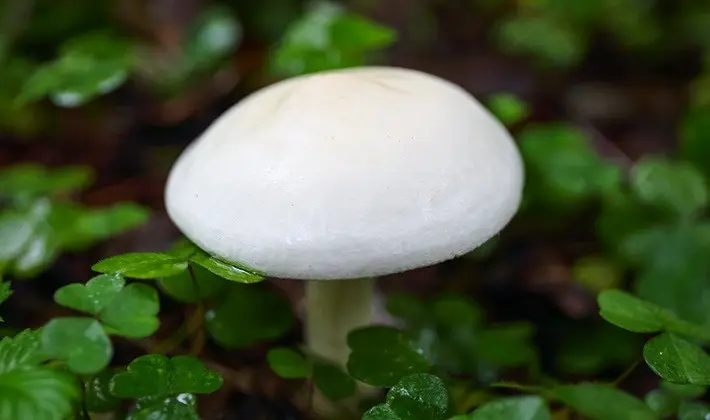
Cap 3-8 cm in diameter, sometimes up to 13 cm, dry, smooth, at first hemispherical, later convex-prostrate. Edges become slightly wavy with age. The color of the cap is whitish or white cream at first, and with age – with buffy or yellowish spots. The edge of the cap is bent down.
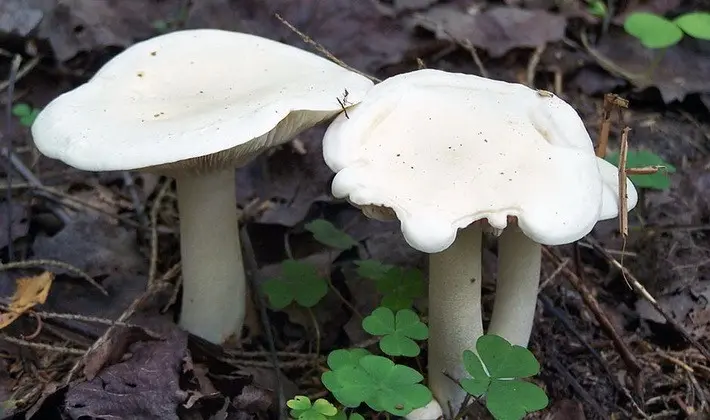
The leg is 4-10 cm high, 6-15 mm thick, cylindrical, dense, elastic, sometimes powdery on top, curved, fibrous. The color of the stem is whitish at first, and later yellowish with a reddish tinge, sometimes brownish at the base and narrowing.
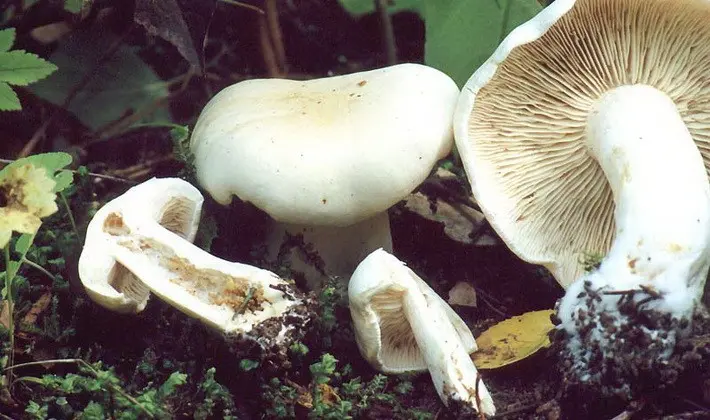
The pulp is white, dense, fleshy, in young mushrooms with a slight odor, and in mature specimens – with a pungent, musty musty smell and pungent taste.
The plates are notched, of unequal length, white, later white-cream in color.
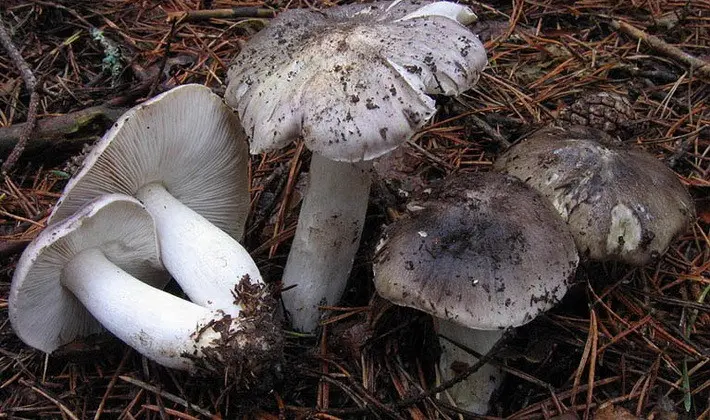
similarity to other species. Row white at an early stage of growth is similar to gray row (Tricholoma portentosum), which is edible and has a different smell, not caustic, but pleasant.
As you grow, the difference increases due to greyish.
They are inedible due to a strong unpleasant odor and taste, which are not eliminated even with a long boil.









